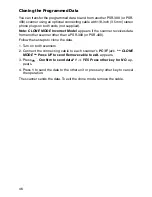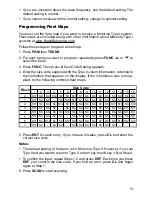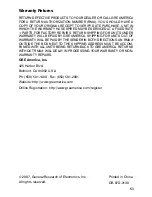
49
Follow these steps to program trunked frequencies:
1. Press
PGM
and select the bank.
Note:
To move through the bank selection faster, press
PGM
then
FUNC
and hold down or . To move through the banks one at a time, repeat the
sequence of
PGM
,
FUNC
then or until you reach the desired bank.
2. Press
TRUNK
to enter the ID program mode.
3. Repeatedly press
MODE
to select Motorola, EDACS (GE/Ericsson), or LTR
(EF Johnson) system to scan. This sets the talk group ID decoding method
to be used for the bank.
Note:
If you select conventional mode instead of Motorola, EDACS, or LTR,
the scanner does not scan trunked frequencies. Trunking mode not selected,
press Mode key.
appears.
4. Press
PGM
to enter the program mode.
5. Enter the desired trunking frequency then press
ENT
to store.
6. To enter additional trunking frequencies as subsequent channels in the same
bank, press
PGM
or to access the next open channel then enter the
frequencies. (See “Storing Known Frequencies into Channels”).
Note:
If necessary, press
MODE
to change the receiving mode.
7. Press
SCAN
to start scanning.
Notes:
• If you enter a frequency that has already been entered into the same bank,
the scanner sounds an error tone and displays
Dupl.Freq.
and the channel
number that has been duplicated. If the dual entry is an error press
CL
and
enter the correct frequency. If the dual entry is intentional press
ENT
to ac-
cept.
• You may replace any frequency by selecting the bank and channel, press-
ing
PGM
and entering the new frequency.
If you make an error in the entry process, press
CL
as often as needed to erase
the incorrect data.
Programming Motorola Trunking Systems (UHF-Lo)
You can program the scanner to receive transmissions in the UHF-Lo band
(406-512 MHz) of the Motorola trunking system. You can receive these trans-
missions by checking the trunking system’s control channel. You must pro-
gram the system’s base frequency and offset frequency to do this.
Note:
Base and offset frequencies vary for each type of trunking system. You
can get information about these frequencies for the trunking system you want
to scan using www.RadioReference.com, other Internet sources, or locally pub-
lished guidebooks.






























